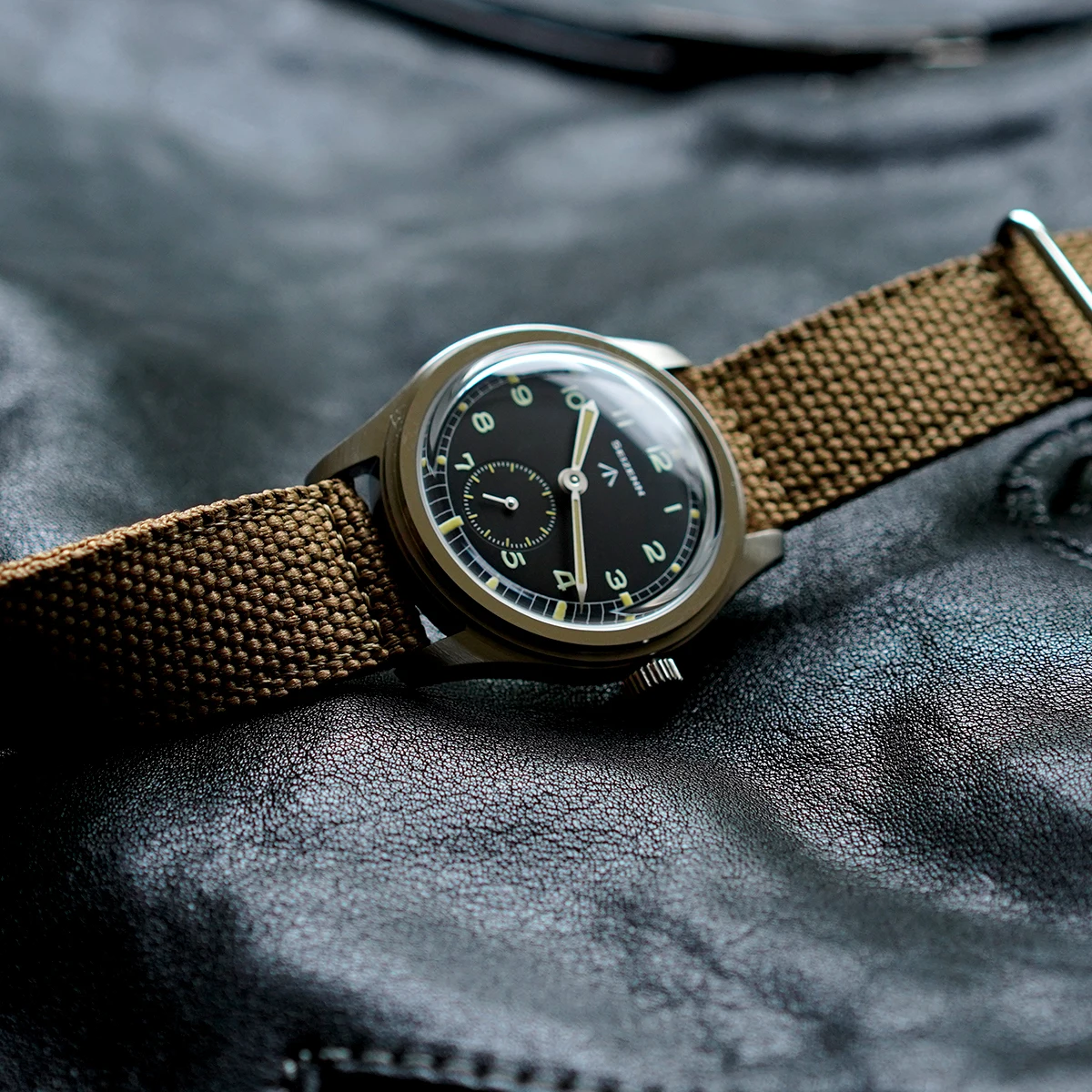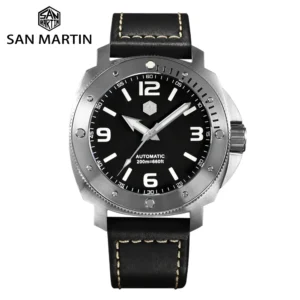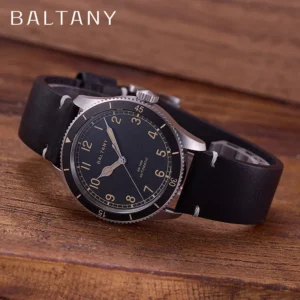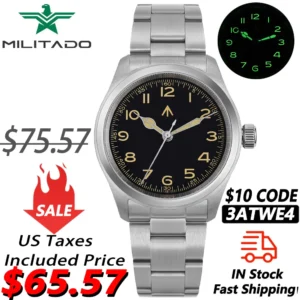From Pocket to Wrist: The Genesis of Aviation Timepieces
The open cockpit of an early aircraft was no place for a pocket watch. Picture yourself in the early days of flight: wind whipping through an uncovered cockpit, vibrations rattling every component of a fragile wooden aircraft, and your hands desperately needed on the controls. In these conditions, the standard gentleman’s pocket watch quickly revealed itself as utterly impractical.
Early aviators faced numerous practical challenges that demanded a rethinking of traditional timekeeping:
- Pilots needed both hands free to operate aircraft controls
- Pocket watches required removing a hand from vital controls to check the time
- Extreme cold and vibration made precise timekeeping difficult
- Navigation calculations required quick, regular time checks
This necessity sparked one of horology’s most significant innovations – the pilot’s wristwatch. The collaboration between Brazilian aviation pioneer Alberto Santos-Dumont and his friend Louis Cartier led to what many recognize as the first purpose-designed pilot’s watch. Santos-Dumont complained about the difficulty of checking his pocket watch while flying, prompting Cartier to create a wristwatch specifically addressing these challenges.
The earliest pilot watches throughout aviation history transformed timekeeping from a matter of social convention to one of practical necessity. As aircraft technology advanced and flights grew longer, accurate timing became essential for navigation, fuel management, and coordination. What began as a practical solution for early aviators soon developed into specialized instruments with features designed specifically for the unique challenges of flight.
These pioneering designs established the foundation for all aviation timepieces to follow. The birth of aviation timepieces marked a significant shift in watchmaking priorities – from decorative accessories to precision tools where readability and reliability couldn’t be compromised. Today, many automatic pilot watches continue to draw inspiration from these original designs, honoring their functional heritage while incorporating modern watchmaking advances.
Essential Design Elements of Early Aviation Timepieces
The unique demands of flight quickly shaped the evolution of pilot watches, creating distinctive design elements that would define the category for decades to come. Every feature of early aviation timepieces served a specific purpose, addressing challenges faced in the cockpit environment.
The most essential design features included:
Oversized dials and numerals: Pilots needed to read time at a quick glance, so watches featured larger-than-typical cases (often 40mm or more when standard watches were 30-34mm) with bold, high-contrast numerals.
Enhanced legibility: Black dials with white markings or vice versa provided maximum contrast. Arabic numerals replaced Roman numerals or decorative hour markers for instant readability.
Luminous elements: Early watches used radium paint (later replaced with safer luminous compounds) on hands and indices to enable reading in darkness or low-light conditions common in early cockpits.
Oversized crowns: These distinctive “onion” crowns weren’t just decorative – they allowed pilots to operate the watch while wearing thick gloves in unheated cockpits.
Secure attachment: Special straps and fixtures ensured the watch stayed firmly attached during aerobatic maneuvers or turbulence.
Anti-magnetic protection: Early aircraft instruments generated magnetic fields that could disrupt watch movements, leading to the development of anti-magnetic shielding.
Shock resistance: Aircraft vibration could damage delicate watch mechanisms, requiring robust construction and shock absorption.
The aviation heritage behind pilot watch features reveals a fascinating intersection of necessity and ingenuity. Each design element evolved as a direct response to the challenges of early flight. As aviation advanced, so did these timepieces, with manufacturers continually refining designs to better serve pilots’ needs.
What makes these watches particularly interesting is how their utilitarian design eventually became their signature aesthetic appeal. Features developed purely for functionality became defining characteristics that distinguished classic pilot watches from other timepiece categories. This form-follows-function approach created an enduring design language that remains influential in watchmaking today.
Great War Influences: Military Standardization of Pilot Watches
The outbreak of the First World War dramatically accelerated the development and refinement of pilot watches. As aircraft evolved from reconnaissance platforms to fighting machines, militaries recognized the need for standardized, purpose-built timekeeping tools for their aviators. This period marked a crucial transition from individually chosen timepieces to military-issued equipment with strict specifications.
The war created unprecedented demand for reliable aviation timepieces, transforming them from novelties into essential military equipment. Military authorities quickly established formal specifications, standardizing features that had previously varied between manufacturers and individual pilots’ preferences.
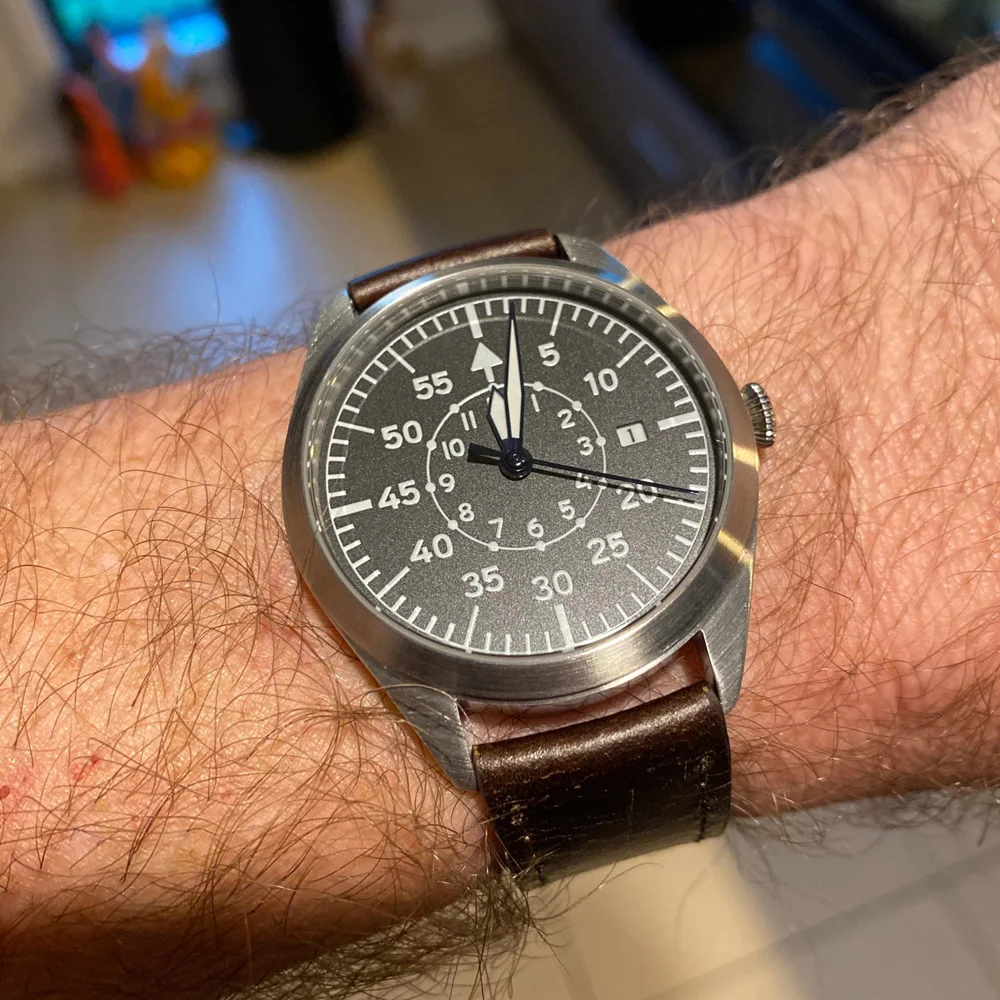
Key developments during this period included:
- The introduction of the first wrist-worn chronographs specifically for aviation use
- Standardized luminous dials using radium compounds for night operations
- The transition from silver and gold cases to more practical steel and nickel
- Military-specified accuracy requirements and testing procedures
- The emergence of specialized suppliers contracted to produce watches to military standards
- Dashboard-mounted chronographs installed directly in aircraft instrument panels
These wartime watches established design precedents that would influence military watch features engineered for extremes for decades to come. The crucible of combat proved which features were truly essential and which were superfluous, refining the pilot watch concept to its most functional form.
The military context also drove production standards and volume manufacturing techniques that would have been impossible in peacetime markets. Watches had to be produced in unprecedented numbers while maintaining strict quality standards under wartime resource constraints.
Today, many military-inspired automatic watches draw direct inspiration from these Great War designs, incorporating elements like wire lugs, cathedral hands, and high-contrast dials that first appeared during this formative period of aviation timekeeping.
Navigation Revolution: The Inter-War Golden Age Advancements
The period between the world wars represented a golden age for aviation timepiece development. As aircraft range and capability increased dramatically, pilots required more sophisticated timing tools to navigate vast distances. This era saw pilot watches evolve from simple timekeepers into complex navigation instruments essential for transoceanic and transcontinental flight.
The interwar period brought remarkable innovations that transformed how pilots used their watches:
The Weems Second-Setting System featured a rotating bezel allowing pilots to synchronize their watches precisely with radio time signals – crucial for accurate celestial navigation.
Hour Angle watches incorporated features specifically for calculating longitude based on celestial observations, with special dials calibrated to convert time into geographic position.
Specialized chronographs emerged with functions for calculating distance, fuel consumption, and ground speed.
Split-second chronograph functions allowed precise timing of multiple events, useful for navigation checkpoints.
These advancements reflect a fascinating chapter in the history of aviation timekeeping tools. As aviation pushed boundaries, so did the watches that enabled these remarkable journeys. The most famous long-distance pilots of the era collaborated directly with watchmakers to develop timepieces addressing the specific challenges they encountered.
What makes this period particularly significant is how it elevated the aviation watch from a simple clock to a sophisticated calculation tool. Pilots relied on these watches not just to tell time but to determine their position over featureless oceans and navigate to distant destinations with remarkable precision.
The legacy of this innovative era continues in modern chronograph pilot watches, which maintain many design elements and functions first introduced during this golden age of aviation timekeeping. While modern pilots have GPS and electronic navigation systems, the mechanical ingenuity of these interwar designs remains impressive even by today’s standards.
Conflict and Innovation: World War II Military Specifications
The Second World War brought unprecedented demands for aviation timepieces, driving significant innovations through rigorous military specifications. The global conflict created distinct evolutionary paths for pilot watches, with Axis and Allied powers developing different approaches to address similar challenges.
On the German side, the B-Uhr (Beobachtungs-uhren or observation watch) represented perhaps the most iconic military pilot watch design ever created. These watches featured:
- Massive 55mm case diameter for maximum legibility
- High-contrast black dials with white indices and hands
- Central seconds hand essential for navigation calculations
- “Triangle with dots” marker at 12 o’clock for instant orientation
- Extra-long leather straps designed to fit over flight jackets
- Two distinct dial designs: Type A (hours 1-12) and Type B (minutes 5-55 with smaller inner hour track)
- Antimagnetic protection and chronometer-grade movements
Meanwhile, Allied forces developed the A-11 specification, resulting in watches with:
- More modest 32-36mm case sizes
- Black dials with white markings
- Hacking seconds function (the second hand stops when setting time) for precise synchronization
- Basic water resistance
- High-grade movements meeting strict accuracy standards
- Simpler, more utilitarian design focused on reliability
These divergent approaches reflected different military doctrines and operational requirements. The German emphasis on celestial navigation required larger, more precisely calibrated instruments, while Allied forces focused on mass-producing reliable timekeepers for their rapidly expanding air forces.
The evolution of pilot watches from cockpit instruments to icons accelerated dramatically during this period. Both approaches influenced post-war watch design, with elements from each tradition appearing in subsequent civilian and military timepieces. The functionality, legibility, and robustness established during this era continue to define what makes a proper pilot’s watch to this day.
This period also saw the refinement of chronograph functions specifically for aviation use, with features like flyback mechanisms allowing pilots to reset and restart timing operations with a single button press – crucial for time-sensitive military operations.
The Jet Age Revolution: Advanced Complications for a New Era
The advent of jet aviation after World War II created entirely new challenges for pilots and watchmakers alike. As aircraft broke the sound barrier and routinely crossed multiple time zones, traditional pilot watches evolved to address these unprecedented operational demands. The jet age saw timepieces transform into sophisticated cockpit calculators with specialized functions beyond simple timekeeping.
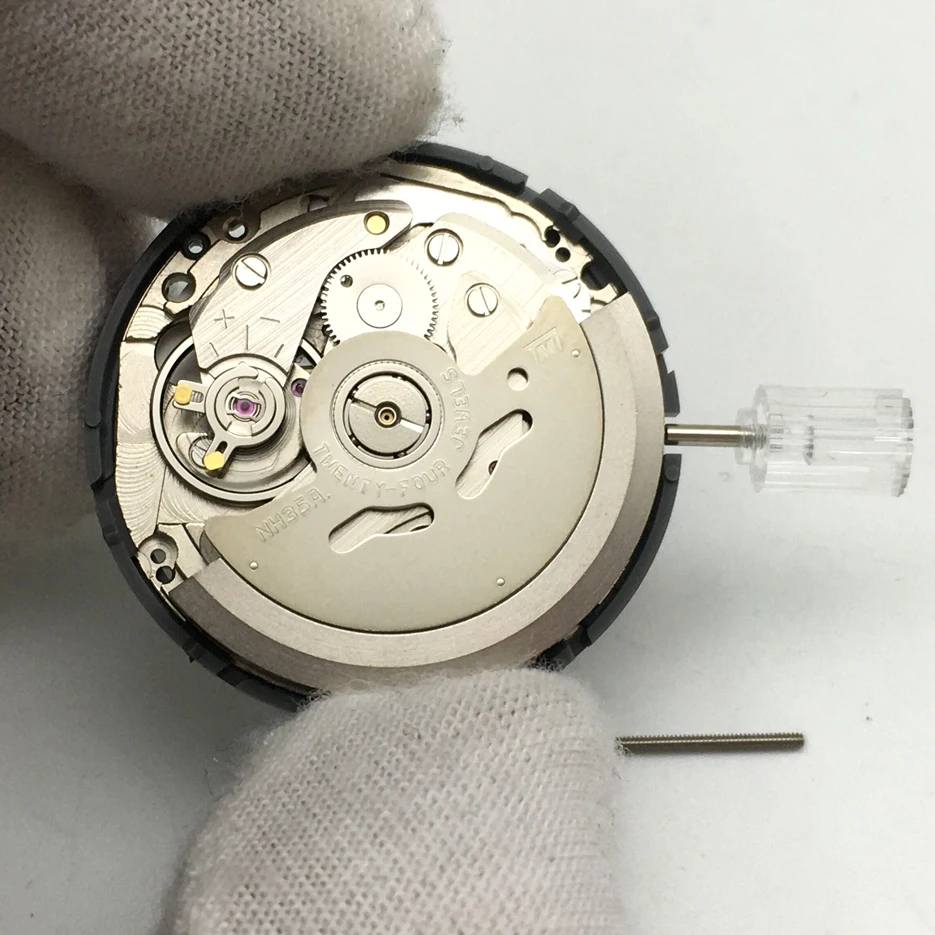
Key innovations of this revolutionary period included:
Slide rule bezels: These circular calculation tools allowed pilots to perform critical mathematics for fuel consumption, distance/speed conversions, and unit conversions without paper calculations.
GMT functions: As intercontinental flight became routine, watches with additional hands and bezels for tracking multiple time zones became essential for navigation and flight planning.
Advanced chronographs: Building on wartime developments, post-war aviation chronographs featured improved legibility, additional scales, and more robust construction.
Automatic winding: Self-winding movements eliminated the need for daily manual winding, ensuring watches maintained power during extended flight operations.
Improved water resistance: As pressurized cabins became standard, watches needed to handle rapid pressure changes without damage.
The jet age represented the peak of the mechanical pilot watch as a practical tool. These timepieces weren’t simply timekeepers but full-fledged navigation computers worn on the wrist. The complexity and capability of these watches grew in direct proportion to the demands of higher, faster flight.
This era also saw significant crossover between military and civilian watch development. Specifications like the French military Type 20/21 influenced commercial chronographs, while innovations from the private sector were quickly adopted for military use. Today, GMT pilot watches continue this tradition, offering practical functionality for modern travelers while honoring their aviation heritage.
Military Inspired Automatic Watches, Rugged Automatic Watches, Tactical Automatic Watches
Price range: $852.14 through $994.60 Select options This product has multiple variants. The options may be chosen on the product pageAutomatic Chronograph Watches, Chronograph Pilot Watches
Price range: $233.36 through $237.58 Select options This product has multiple variants. The options may be chosen on the product pageClassic Automatic Dress Watches, GMT Automatic Watches, GMT Pilot Watches
Price range: $1,240.86 through $1,463.33 Select options This product has multiple variants. The options may be chosen on the product pageBronze Automatic Watches, Military Inspired Automatic Watches, Professional Spec Dive Watches
Price range: $1,442.21 through $1,442.82 Select options This product has multiple variants. The options may be chosen on the product pageClassic Pilot Watches, Military Inspired Automatic Watches
$561.00 Select options This product has multiple variants. The options may be chosen on the product pageClassic Field Watches, Military Inspired Automatic Watches
Price range: $280.87 through $338.51 Select options This product has multiple variants. The options may be chosen on the product page
Cockpit Instruments: The Practical Applications of Aviation Timepieces
Beyond their impressive technical specifications, early aviation watches served critical practical functions that directly impacted flight safety and mission success. Understanding how pilots actually used these timepieces reveals why certain features were not merely decorative but essential for aviation operations.
Navigation was perhaps the most vital application. Before electronic navigation aids, pilots relied on dead reckoning – the process of calculating current position by using a previously determined position, known speed, elapsed time, and course. This required:
- Precise timing of leg distances between checkpoints
- Calculating ground speed based on time over known distances
- Determining drift correction based on timing observations
- Converting time to distance using the E6B flight computer alongside the watch
Fuel management depended heavily on accurate timing:
– Tracking fuel consumption rates required precise timing of tank depletion
– Calculating range and endurance involved time/fuel burn mathematics
– Reserve planning relied on accurately timing flight segments
Operational timing was equally critical:
– Formation flying required synchronized watches across multiple aircraft
– Mission timing often depended on watches rather than unreliable radio communications
– Coordinated military operations relied on precisely synchronized timepieces
The importance of mastering essential pilot chronograph features cannot be overstated. These weren’t luxury accessories but literal lifesaving tools. In an era before autopilots and GPS, a pilot’s ability to navigate safely often came down to the accuracy of their timepiece and their skill in using it.
What makes these applications particularly fascinating is how they elevated simple time measurement into complex problem-solving. Pilots developed specialized techniques for using their watches in conjunction with other instruments, creating systems and procedures that remained standard practice for decades.
Iconic Manufacturers: Pioneers in Aviation Timekeeping
Several visionary manufacturers emerged as leaders in aviation horology, each contributing unique innovations that shaped the development of pilot watches. These companies didn’t merely adapt existing designs for aviation use – they fundamentally reimagined what a wristwatch could be when purpose-built for the cockpit.
Among the most influential manufacturers:
Longines pioneered aviation timekeeping with early pilot-specific designs and later developed the Hour Angle watch with navigational calculations built into the design.
Breitling specialized in chronographs and slide rule bezels, creating calculation tools that served as wrist-worn flight computers.
IWC produced the iconic B-Uhr observation watches and later became known for anti-magnetic pilot watches with exceptional legibility.
Zenith manufactured specialized chronographs including the famous “Type 20” models with flyback functionality for military pilots.
Stowa and Laco created observation watches to exacting German military specifications, establishing design standards that influence pilot watches to this day.
What distinguished these manufacturers was their close collaboration with actual pilots to develop solutions to specific aviation challenges. This user-centered approach resulted in timepieces that were truly fit for purpose rather than merely styled to suggest aviation connections.
These aviation milestones and iconic watch designs established design languages and technical standards that defined entire categories of watches. The competition between these manufacturers drove rapid innovation, with each company striving to create more capable, reliable instruments for increasingly demanding flight conditions.
The legacy of these pioneering companies continues today, with many still producing watches that draw direct inspiration from their historical aviation models. Their early innovations established design principles and technical standards that remain influential across the entire watchmaking industry.
Do Modern Cockpit Watches Serve the Same Purpose?
Today’s glass cockpits with GPS navigation, digital displays, and onboard computers raise an interesting question: do modern pilot watches still serve their original purpose, or have they become primarily symbolic links to aviation heritage?
The reality is nuanced. Modern aviation relies primarily on sophisticated electronic systems for navigation, timing, and calculations once performed using watches. Commercial airline pilots today have minimal practical need for the specialized features developed for early aviators.
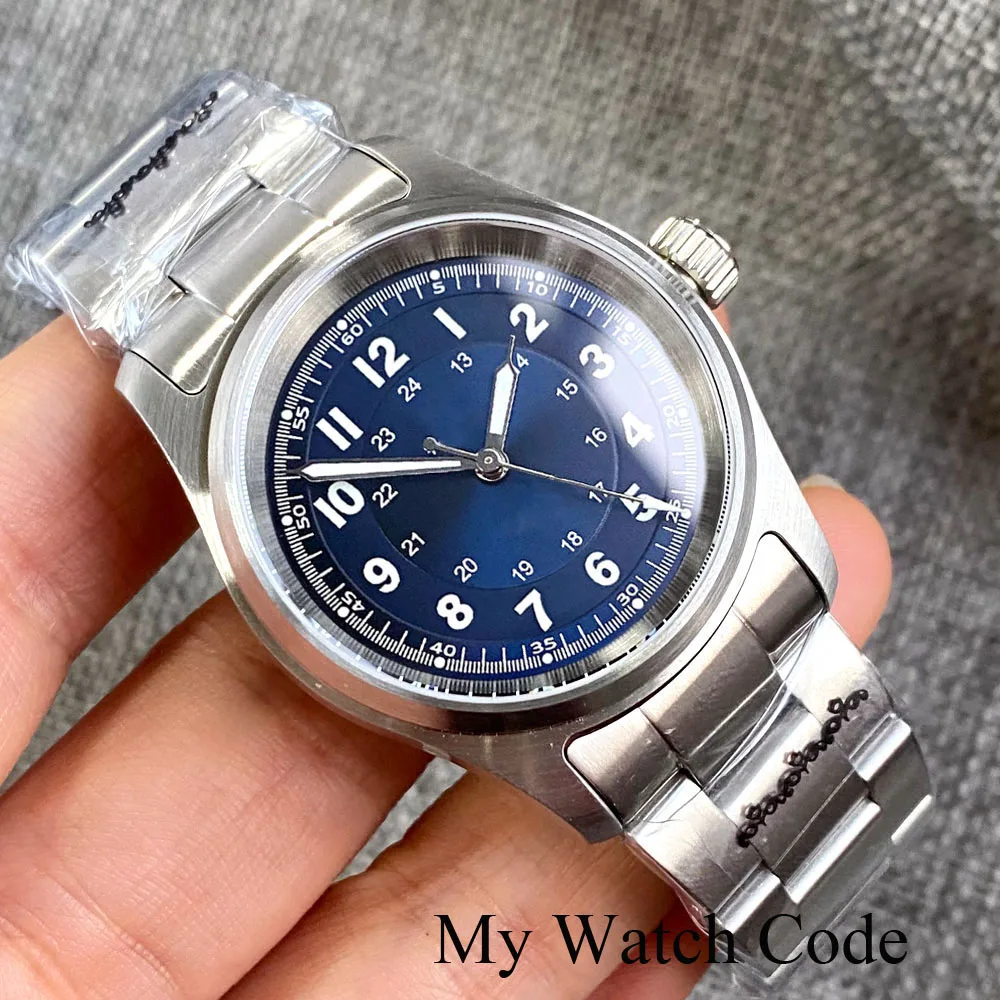
However, pilot watches maintain relevance in several important contexts:
Redundancy: Mechanical watches provide backup timekeeping independent of aircraft electrical systems, following aviation’s principle of multiple redundant systems.
Specialized operations: Military, aerobatic, and bush pilots still benefit from traditional features like high legibility and chronograph functions.
Training environments: Student pilots often learn fundamental navigation calculations using traditional methods before transitioning to electronic systems.
Practical simplicity: The ability to quickly reference time without activating screens or navigating digital menus remains valuable in high-workload cockpit environments.
Modern pilot watches typically retain the core DNA of their predecessors – exceptional legibility, robust construction, and precision timekeeping – while incorporating contemporary materials and manufacturing techniques. The transition from cockpit instrument to icon reflects how these watches have evolved beyond purely utilitarian tools to become symbols of aviation’s spirit of precision and adventure.
While digital instruments may handle most cockpit calculations, the pilot watch remains relevant as both practical tool and connection to aviation heritage. Its evolution from necessity to tradition mirrors aviation’s own journey from dangerous experiment to commonplace technology.
The Collector’s Perspective: Why Early Cockpit Watches Remain Significant
The enduring appeal of early aviation timepieces extends far beyond their original utilitarian purpose. These watches connect enthusiasts to pivotal moments in aviation history while representing significant achievements in watchmaking innovation and design.
For collectors and enthusiasts, early cockpit watches offer compelling attributes:
Historical significance: These timepieces witnessed and enabled aviation milestones, making them tangible connections to breakthrough moments in human achievement.
Design authenticity: Unlike many modern watches with styling that merely suggests purpose, early pilot watches were genuinely designed for specific, life-critical functions.
Technical innovation: Many features now common in watchmaking first appeared in aviation timepieces, making them important chapters in horological development.
Aesthetic influence: The clean, functional design language pioneered in cockpit watches has influenced watch design across many categories.
Investment value: Original military-issue pilot watches, particularly those with documented provenance, have shown remarkable appreciation in value.
The stories of watches worn by aviation pioneers add another dimension of significance. Knowing a particular watch design accompanied historic flights or served in momentous air campaigns connects the wearer to those achievements in a personal way.
What makes these timepieces particularly compelling is how their design perfectly balanced form and function. Unlike purely decorative watches or single-purpose tools, pilot watches achieved an elegant harmony where every design element served a practical purpose while creating a distinctive and appealing aesthetic.
At Sharp Aspect, we recognize this special heritage. The influence of these pioneering timepieces continues in contemporary watchmaking, with many modern watches incorporating design elements and functions first developed for early aviators. Their legacy demonstrates how purposeful design driven by genuine need often creates objects of lasting significance and appeal.

